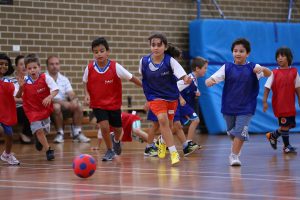A True Middle School Physical Education Program:
Having taught middle school students and supervised middle school physical educators, the author, Mike Tenoschok, has studied how to create the best middle school program. He concludes that the most effective middle school programs engage students in a wide range of activities.
He believes that middle school is the perfect time to present students with the opportunity to pick sports that interest them, so that they can be doing something they actually want to be doing. Elementary school focuses on basic skill development. High school is a time to really focus and improve on one or two sports. Middle school is the perfect time to pick the sports you want to specialize in and focus on in high school, while having the basic abilities to experiment with the different sports (what was taught in elementary school). This exploration is only possible if there are multiple options provided to the students.
Tenoschok suggests that providing students with as many activities as possible, while covering twelve overarching areas is the most effective route to take. He focuses on hybrid games. Hybrid games are traditional games combined together to increase and maximize participation through different rules, equipment, players, or turf. He first came upon this out of necessity, as his classes were too large. However, after using this method he found this is the best way to expose students to as many sports as possible.
Tenoschok, M. (2016). A True Middle School Physical Education Program. Journal of Physical Education, Recreation & Dance, 87(6), 9-15. Retrieved May 12, 2017.

School Physical Education: The Pill Not Taken:
This article aims to evaluate physical education in relation to physical activity, describe the current status of physical education through its history, and ends with recommendations for improvement.
Physical education programs in schools can teach basic leadership and team skills, increase fitness, and promote a healthy lifestyle. This article states, “If ‘exercise is medicine,’ physical education is the pill not taken.” So many obstacles stand in the way of students getting the proper physical education they need. For example, inadequate resources, limited curriculum time allocations, and more.
The article results in four recommendations to improve physical education in schools:
1.) Schools should be required to provide physical education programs that meet national standards. The programs should improve the students behavioral and motor skills.
2.) Only qualified professionals should be able to teach physical education in schools.
3.) Schools should be held responsible by states to meet the national standards for physical education.
4..) Colleges and Universities should create programs that produce qualified professionals prepared to teach physical education in schools.
McKenzie, T. L., & Lounsbery, M. A. (2009). School Physical Education: The Pill Not Taken. American Journal of Lifestyle Medicine, 3(3), 219-225. Retrieved May 12, 2017.
